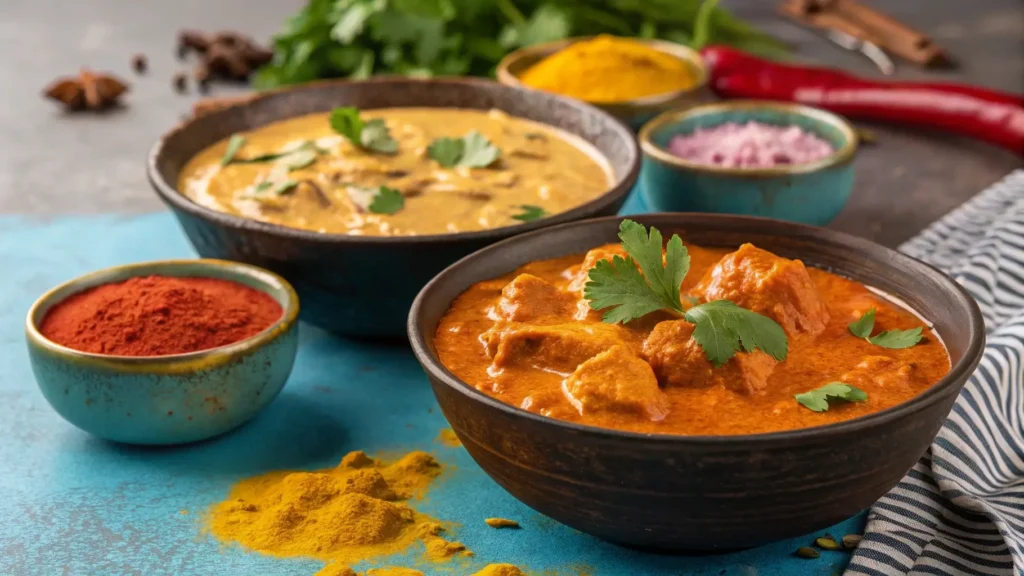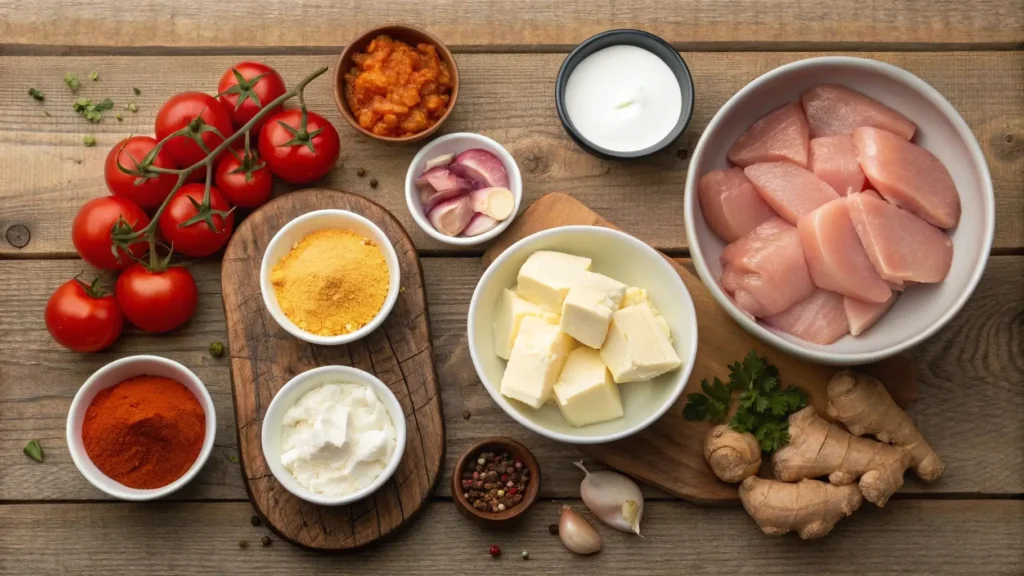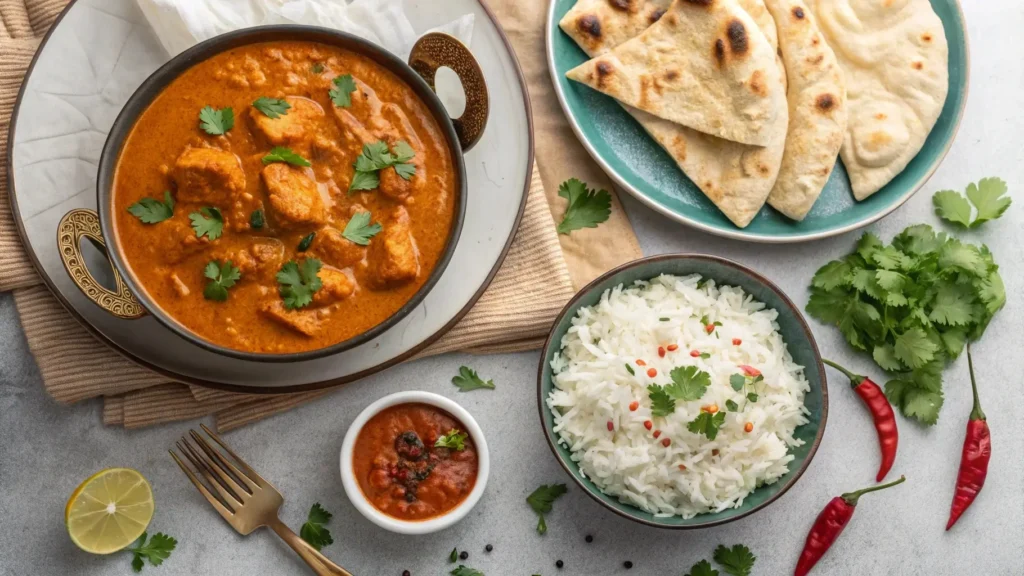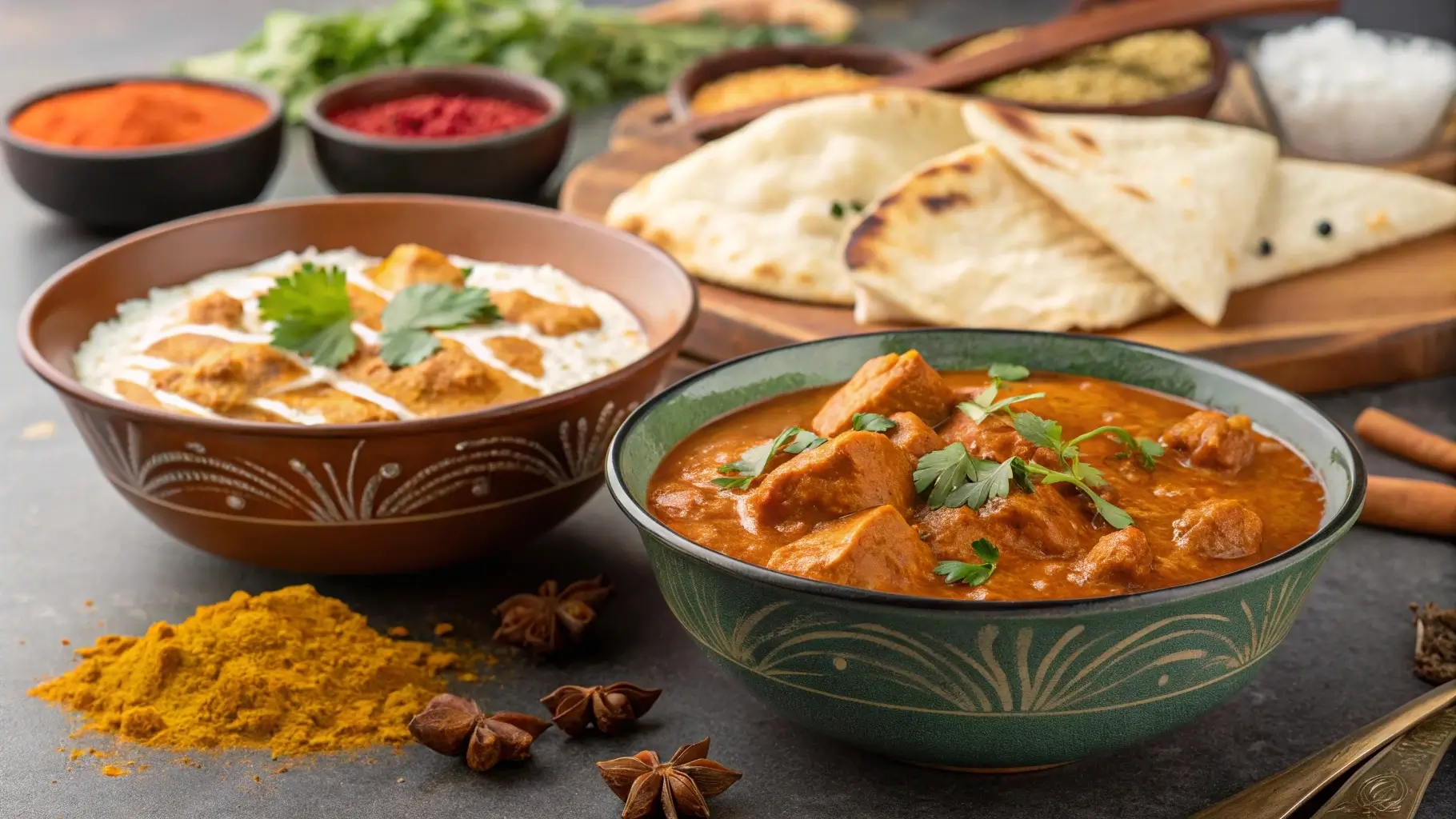When it comes to delicious Indian cuisine, two dishes often steal the spotlight: butter chicken and chicken tikka masala. Both are rich, flavorful, and immensely popular worldwide. But when you’re balancing your love for curries with health-conscious choices, the question arises: Is butter chicken healthier than tikka masala?
In this article, we’ll delve deep into their nutritional profiles, ingredients, and health impacts. We’ll compare their calorie counts, fat content, and suitability for different diets. By the end, you’ll have all the insights you need to make an informed choice about which dish suits your health goals better. Let’s begin with a closer look at these culinary stars.
Table of contents
- Introduction to Butter Chicken and Tikka Masala
- Nutritional Profiles of Butter Chicken and Tikka Masala
- Ingredients and Their Impact on Health
- Cooking Methods and Health Implications
- Health Comparisons Based on Dietary Needs
- Tips for Making Healthier Versions at Home
- FAQs: Is Butter Chicken or Tikka Masala Healthier for You?
- Conclusion: Which Dish Is Healthier?

Introduction to Butter Chicken and Tikka Masala
What Are Butter Chicken and Tikka Masala?
Butter chicken, also known as Murgh Makhani, is a creamy and mildly spiced curry that originated in India. It’s characterized by its rich, velvety texture achieved using cream and butter. Chicken tikka masala, on the other hand, is a slightly spicier, tomato-based dish believed to have been popularized in the UK. Both share a similar core ingredient—chicken—but their sauces and flavor profiles set them apart.
While butter chicken is sweet and indulgent, tikka masala offers a tangy kick. This distinction not only shapes their taste but also plays a role in their nutritional values.
Origins of the Dishes: Butter Chicken vs. Tikka Masala
Butter chicken traces its roots back to Delhi in the 1950s, where it was invented as a way to use leftover tandoori chicken. With the addition of butter, cream, and spices, this dish quickly became a favorite in Indian households. Chicken tikka masala, however, is often associated with Indian restaurants in the UK, blending Indian and British culinary influences.
Despite their shared heritage, the two dishes cater to different palates and dining experiences. Butter chicken is seen as a traditional Indian comfort food, while tikka masala reflects a more globalized adaptation of Indian flavors.
Why Compare Their Health Benefits?
Both butter chicken and tikka masala are decadent, but their ingredients and preparation methods can influence their health impact. As diets evolve and people seek healthier options, understanding these dishes becomes more important. For instance, butter chicken often contains more cream and butter, potentially increasing its calorie and fat content. Meanwhile, tikka masala’s tomato-based sauce may contain higher sodium levels.
Knowing these differences can help you pick a dish that aligns better with your dietary preferences—whether you’re counting calories, reducing fat, or cutting down on carbs. So, is one really healthier than the other? Let’s find out as we move further.
Nutritional Profiles of Butter Chicken and Tikka Masala
Calories in Butter Chicken vs. Tikka Masala
When comparing butter chicken and chicken tikka masala, calorie count is often the first metric to evaluate. A typical serving of butter chicken contains approximately 450–500 calories, thanks to its creamy sauce made with butter and cream. On the other hand, chicken tikka masala usually clocks in at around 350–400 calories per serving. The difference arises primarily due to tikka masala’s tomato-based sauce, which is generally lighter.
If you’re watching your calorie intake, tikka masala might seem like the healthier choice. But does this mean butter chicken is inherently unhealthy? Not necessarily—it all depends on portion size and how each dish is prepared.
Fat and Saturated Fat Content
Butter chicken gets its signature richness from butter and heavy cream, contributing to higher fat and saturated fat levels. A serving can contain around 25–30 grams of fat, with about 10–12 grams of saturated fat. In contrast, tikka masala, though not fat-free, typically has less fat—approximately 15–20 grams, with 5–8 grams of saturated fat.
Dietary fat isn’t inherently bad, but saturated fat in excess can be linked to heart health concerns. For those aiming to limit their intake of saturated fats, chicken tikka masala may seem like the safer bet. However, swapping cream in butter chicken for lighter alternatives, like yogurt, can significantly cut down its fat content.
Protein and Carb Composition
Both dishes are excellent sources of protein, offering about 30–35 grams per serving, depending on the chicken portions used. Carbohydrate content, however, differs due to the sauces. Butter chicken tends to be lower in carbs (around 8–10 grams) compared to tikka masala, which may contain 12–15 grams due to its tomato-heavy base.
For those on a low-carb diet, butter chicken could be the better option. That said, pairing either dish with naan or rice will naturally increase overall carb intake.
Sodium Levels in Both Dishes
One surprising factor to consider is sodium. Tikka masala’s tangy tomato sauce often contains added salt to balance its flavors, leading to higher sodium content—up to 1,000 milligrams per serving. Butter chicken, while still salty, generally contains slightly less sodium, averaging around 800 milligrams.
In conclusion, is butter chicken healthier than tikka masala? From a sodium perspective, butter chicken may have a slight edge, but for calorie-conscious diners, tikka masala often wins.
Ingredients and Their Impact on Health
Core Ingredients of Butter Chicken
Butter chicken revolves around a handful of indulgent ingredients: marinated chicken, butter, cream, and a mix of spices. These elements create its creamy texture and mild flavor. However, butter and cream are high in saturated fats, which can contribute to increased calorie content and cholesterol levels.
To reduce its calorie load, many home cooks opt for healthier substitutes like Greek yogurt or cashew cream. Additionally, using lean chicken breast instead of thighs can cut down on fat without sacrificing protein.
Core Ingredients of Tikka Masala
Chicken tikka masala relies on marinated chicken, a tomato-based gravy, and a rich blend of spices like turmeric, cumin, and coriander. The dish may also include yogurt for marination and a touch of cream to enhance the sauce. Tomatoes provide a good dose of vitamin C and antioxidants, making tikka masala slightly more nutrient-dense.
However, pre-made sauces and restaurant versions often contain added sugars and salt, which can counterbalance the health benefits of its ingredients. When made at home, using fresh tomatoes and limiting salt and sugar can make tikka masala much healthier.
Use of Cream and Butter in Butter Chicken
Cream and butter are the heart of butter chicken. While they add richness and depth, they also significantly increase fat and calorie content. Substituting these ingredients with lighter options like low-fat milk or plant-based alternatives can reduce the dish’s impact on your waistline without compromising flavor.
Tomato Base in Tikka Masala
Tomatoes are the hero of tikka masala’s sauce. They not only lend a tangy flavor but also bring essential nutrients like potassium and vitamins A and C. However, the dish can become less healthy if too much oil or cream is added during preparation. Balancing these ingredients ensures that the tomato base remains the star without unnecessary calories.
By understanding these ingredients’ health impacts, you’re one step closer to deciding: is butter chicken healthier than tikka masala?

Cooking Methods and Health Implications
Traditional Cooking Techniques
Butter chicken and chicken tikka masala differ in both taste and preparation. For butter chicken, chefs marinate the chicken and cook it in a tandoor or pan-fry it before simmering it in a creamy, spiced sauce. Butter and cream enhance its rich flavor but also increase its calorie and fat content.
Chicken tikka masala typically starts with tandoori-style chicken. Chefs roast or grill the marinated chicken, locking in flavor while keeping fat content low. They then combine the chicken with a tomato-rich gravy seasoned with cumin, turmeric, and garam masala, creating a vibrant, slightly tangy dish. While this method reduces fat, it can raise sodium levels because of the salt often added to the sauce.
Modern Healthy Alternatives
Nowadays, there are numerous ways to prepare these dishes with a health-conscious twist. Substituting cream in butter chicken with yogurt or almond milk can significantly lower fat content. Similarly, reducing the use of butter or opting for ghee, which is rich in healthy fats, can help. For tikka masala, cutting down on salt or using fresh tomatoes instead of canned ones can lower sodium levels.
For more on healthier butter chicken preparations, you might find the insights in “Is Butter Chicken Healthy? Analyzing This Popular Dish” helpful.
Health Comparisons Based on Dietary Needs
For Weight Loss: Which Is Better?
When it comes to weight loss, tikka masala may edge out butter chicken due to its lower calorie and fat content. Butter chicken’s creamy sauce can quickly add extra calories, especially when paired with naan or rice. Tikka masala, with its tomato-based sauce, is naturally lighter, making it a better option for those aiming to shed pounds. But moderation is key for both dishes!
For Heart Health and Cholesterol
For heart health and cholesterol, tikka masala offers a safer choice. Its tomato-based sauce uses little to no dairy, resulting in lower saturated fat levels compared to butter chicken. Butter chicken, on the other hand, often relies on cream and butter, which can increase saturated fat intake and potentially impact heart health. By preparing low-fat versions of either dish—such as using yogurt instead of cream or reducing butter—you can make them more suitable for a heart-healthy diet.
Which Dish Is More Diabetic-Friendly?
Butter chicken, with its lower carb count, may be a better choice for people managing diabetes. Its creamy sauce generally has fewer carbohydrates compared to the tomato-based tikka masala, which can have added sugar in some recipes. That said, preparing either dish at home allows for better control over ingredients, ensuring they fit within a diabetic-friendly meal plan.
For more recipe inspiration, check out the creative cooking ideas on Kamala Recipes.
Tips for Making Healthier Versions at Home
Reducing Cream and Butter in Butter Chicken
If you love butter chicken but want a lighter version, there are plenty of ways to tweak the recipe. Start by replacing heavy cream with Greek yogurt or coconut milk. These alternatives retain the creamy texture but cut down on saturated fat. Additionally, using a smaller amount of butter—or swapping it for ghee—provides a rich flavor while reducing calories.
Another tip is to add pureed cashews or almonds to the sauce for natural creaminess. This adds healthy fats and nutrients without compromising the taste. With these adjustments, butter chicken can become a more heart-friendly dish while still being indulgent.
Low-Sodium and Low-Carb Tikka Masala Options
To make tikka masala healthier, focus on reducing sodium and carb content. Opt for fresh tomatoes instead of canned ones to avoid extra salt, and use spices like cumin, turmeric, and coriander to enhance flavor naturally. If you’re worried about sugar, check the labels of store-bought sauces or prepare the dish from scratch.
For those watching their carb intake, serve tikka masala with cauliflower rice or quinoa instead of traditional basmati rice. These swaps ensure you can enjoy this flavorful dish without exceeding your dietary goals.
Plant-Based Substitutes for Both Dishes
Both dishes can easily be made vegetarian or vegan. Replace chicken with tofu, chickpeas, or paneer for a plant-based twist. Use plant-based yogurt or almond cream to maintain the same rich flavors. These adaptations make the dishes accessible to a wider audience while boosting their health quotient.
FAQs: Is Butter Chicken or Tikka Masala Healthier for You?
Is tikka masala or butter chicken healthier?
How healthy tikka masala or butter chicken is depends largely on preparation. Tikka masala often stands out as the healthier choice because its tomato-based sauce typically has fewer calories and less fat than butter chicken. This is especially true when it uses minimal cream or butter. However, restaurant versions of tikka masala can include high sodium levels and added sugar. On the other hand, butter chicken offers a creamier, richer flavor but can be made healthier by replacing cream with yogurt or reducing the amount of butter used. Both dishes can work for different dietary needs, but tikka masala usually remains the better option for those watching their calorie or fat intake.
Is butter chicken healthy or unhealthy?
Butter chicken can be both healthy and indulgent, depending on the preparation. Traditional recipes include butter and cream, which add saturated fat and calories, making it less ideal for those watching their fat intake. However, healthier versions—using Greek yogurt, almond milk, or less butter—can significantly improve its nutritional profile. With the right adjustments, butter chicken can be a balanced meal rich in protein and flavor.
Is tikka masala healthy or unhealthy?
Tikka masala is generally healthier than butter chicken, thanks to its tomato-based sauce, which is lower in calories and fat. However, it can still be unhealthy if prepared with excessive oil, salt, or sugar, as seen in many restaurant versions. Homemade tikka masala with fresh ingredients and controlled seasoning can make it a healthy choice, rich in nutrients like vitamin C and potassium.
Is butter masala healthy?
Butter masala, like butter chicken, can be indulgent due to its use of cream and butter. While delicious, it may not suit low-fat diets. That said, healthier versions using lighter substitutes like yogurt or plant-based creams can transform butter masala into a nutritious and satisfying dish. Moderation and ingredient adjustments are key to making butter masala a balanced part of your diet.
For more tips on creating healthier versions of these dishes, check out the guide on “Is Butter Chicken Healthy?”.
Conclusion: Which Dish Is Healthier?
Final Verdict Based on Key Comparisons
So, is butter chicken healthier than tikka masala? The answer depends on how each dish is prepared and your dietary needs. Butter chicken tends to have higher calories and saturated fats due to its creamy, buttery base, making it less ideal for those watching their fat intake. However, its lower carbohydrate content can make it a better choice for low-carb diets.
On the other hand, tikka masala often wins in terms of being lighter, with fewer calories and fat. Its tomato-based sauce adds a boost of nutrients like vitamin C and potassium, but restaurant versions can contain added sugars and sodium, which might not be suitable for all health goals.
Ultimately, both dishes can be adjusted to suit your needs. With a few ingredient swaps—like using yogurt instead of cream in butter chicken or fresh tomatoes in tikka masala—you can enjoy a healthier version of either curry without sacrificing flavor.
Personal Preferences and Dietary Choices
Ultimately, your choice between butter chicken and tikka masala depends on your personal taste and dietary needs. If you enjoy creamy, indulgent flavors, butter chicken delivers. However, if you prefer a tangy, tomato-based curry, tikka masala suits your palate better. The best part? You can customize both dishes to balance flavor and health, making them equally enjoyable.


